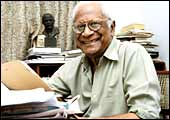 |
| CPI's Bardhan: Leading the anti-Korean
propaganda |
It's
now the turn of the Koreans to be at the receiving end of communist
vitriol. On June 8, the Tamil Nadu unit of the Communist Party
of India (CPI) announced a campaign to drive Korean companies
out of the state. The provocation: South Korean giant LG's decision
to sever links with its Indian partner, Indian Household and Healthcare
Ltd (IHHL), following the scrapping of Press Note 18. According
to the Reds, this is yet another case of the concession being
misused by MNCs to boot out Indian collaborators. Well, well!
Since when has the party of the proletariat revolutionary become
the voice of Indian industry?
Interestingly, the same day, CPI's feisty
general secretary, A.B. Bardhan, launched a broadside against
the Naveen Patnaik government in Orissa over its proposal to lease
iron ore mines to South Korean steel giant Posco. "Posco
will plunder the mineral wealth of the country," he thunders.
Er... The South Koreans are planning to set up a 10-million-tonne
mega-steel plant in the state, Sir. They need the ore for this.
"Rubbish," retorts the grand revolutionary, "it's
only three million tonnes. The rest is only a promise. Let them
buy their ore from the Orissa Mining Corporation. But no, the
government would rather let them loot the country."
Bardhan, however, clarifies that his party's ire is aimed specifically
at the two "erring" South Korean entities and not at
every company hailing from that country. But what does he have
to say about LG's reported plans of investing in the Left Front-ruled
West Bengal? "That's for the West Bengal government to decide.
What can I say?" he responds.
Ah! At least the party's precepts are flexible
enough to accommodate its politics.
-Arnab Mitra
Fixing
The Fiscal Deficit
Last year's fiscal deficit was lower than
projected. Will it stay that way?
 |
| FM Chidambaram: A balancing act |
It
was a pleasant surprise to everyone, including the government,
when a justifiably proud Finance Minister P. Chidambaram announced
earlier this month a final fiscal deficit figure of 4.1 per cent
for 2004-05, a good 0.4 percentage point lower than the Fiscal
Responsibility and Budget Management (FRBM) Act's 4.5 per cent
figure. The question is, what has brought about the unexpected
drop in deficit? Is it, like one Delhi-based economist says, "just
a fluke", or will Chidambaram press the "pause button"
like he mentioned in his budget speech?
On the revenue side, a buoyant industrial
scenario has swelled government coffers by way of both non-tax
(essentially dividend receipts from public enterprises) and tax
revenues. While the former is up 7 per cent, the latter has managed
a 1.4 per cent increase over initial estimates, despite lower
taxes and duties. "But expenditure contraction looks like
the more likely reason for lower deficit," says Indranil
Pan, Chief Economist at the Mumbai-based Kotak Mahindra Bank.
He's right. Both Plan and non-Plan expenditure fell short by 3.8
per cent and 0.6 per cent respectively in 2004-05.
Can the fm maintain this tempo of higher
revenues and lower spending this year too? Looks unlikely. "The
UPA Common Minimum Programme's (CMP) expenditure crunch will start
to kick in this year onwards," says Rajiv Kumar, Chief Economist
at CII. The Prime Minister has already announced the mammoth Bharat
Nirman scheme that will guzzle Rs 1,74,000 crore in the next five
years. Many economists concur that agriculture, education and
rural infrastructure may not have the capacity to take in this
huge investment, and that there would be immense leakages here,
making it both fiscally imprudent and socially wasteful.
It remains to be seen how the fm balances
this huge expenditure mobilisation with his promise to lower central
government borrowings in the current financial year. Fortunately
for the fm, revenue collections look promising. If the GDP grows
by the expected 7 per cent, then the government's revenues could
surge by 17 per cent. Value-added tax and fringe-benefit tax seem
like big revenue earners, although disinvestment is unlikely to
fetch the Rs 7,000 crore Chidambaram hopes to raise this year.
"You cannot expect me to go back to 4.3 per cent (fiscal
deficit as a percentage of GDP) when I actually achieved 4.1 per
cent," he told journalists last fortnight. Nobody expects
him to. But, then, unexpected things do happen.
-Shailesh Dobhal
HURRAH
Back In The AIDS Business
Late
last month, Ranbaxy became the first company in India to receive
the US food and drug Administration's (FDA) tentative approval
for its anti-retroviral (ARV) drug, Lamivudine (150 mg tablets),
for AIDS under the US President's Emergency Plan for AIDS Relief
(PEPFAR) programme. It's a quick change in fortunes for Ranbaxy's
AIDS drug. Last November, the company had voluntarily withdrawn
its ARVs from the World Health Organization's prequalification
list after it found that the CRO (clinical research organisation)
that had tested the drugs had not followed international standards.
The USFDA approval, then, is a shot in the arm for Ranbaxy's low-cost
ARVs business. "This is a major step in making our life-saving
ARV medicines available to more and more HIV/AIDS patients in
the developing world," Brian W. Tempest, Ranbaxy's CEO and
Managing Director, said in a statement. Ranbaxy has already filed
11 ARVs with the WHO for approval, which is expected soon.
-E. Kumar Sharma
Biscuit Brouhaha
Biscuit makers protest the crunch of high
taxes.
 |
| FBMI's Aggarwal: The cookie crumbles |
It's
the proverbial crunch in the munch. The issue? States are levying
a 12.5 per cent value-added tax (VAT) on biscuits while the Centre
takes its cut by way of an 8 per cent excise duty. The fear? These
will take the country's favourite munchy out of reach of the common
man and drive several small biscuit makers out of business.
The Federation of Biscuit Manufacturers of
India (FBMI), which has taken up the issue with the government,
does have a point. Why has the finance ministry lumped biscuits
with luxury and "non-essential" goods like white goods
and personal care products like toothpastes in the 12.5 per cent
VAT category? "After all, namkeen, dry fruits and juices
all fall under the lower 4 per cent category, so why shouldn't
we?" the association asks.
B.P. Aggarwal, Chairman of Priyagold Biscuits
and President of FBMI, says the VAT impacts not just small biscuit
manufacturers, but even big players. "It raises biscuit prices
and forces the lower income groups, who consume a lot of biscuits,
to buy other foodstuff." Aggarwal adds that biscuit manufacturers,
who had toyed with the idea of an industrywide strike to press
their point, have decided to put their threat on hold for the
time being. They are hoping that their repeated representations
to the government will do the trick. And it's not just VAT that
they're up against. The FBMI is also targeting the 8 per cent
excise duty. "Is it fair that namkeen and juice manufacturers
don't pay excise but we do?" Aggarwal asks.
-Kushan Mitra
Trying
Harder
Can Fiat break its Indian jinx?
 |
| Fiat's Castagno: Hoping for a magical
revival |
Fiat
India seems to be following sir Robert Bruce's dictum 'Try, try
and try again'. It is now trying to crack open the Indian market
with its latest launch, the Rs 5.58-lakh (ex-Mumbai) Fiat Adventure
Sport. Paolo Castagno, the company's Managing Director, says it
is important to communicate the car's many attributes to the customer.
"We're offering a high-end (actually C segment) car and that's
exactly what the positioning will be. This needs to be done since
it is not a mass product," he says, adding that this time,
the company will ensure that after-sales services are readily
and easily available "because it is not enough if you just
have a good product."
Ironically, despite an over 50-year presence
in the Indian market, Fiat remains a bit player here. Its brand
has been substantially eroded and it sells barely 200 Palios and
Siennas a month. How does Castagno plan to revive the magic of
the Fiat brand? "Customers here need a good mix of product
and price. It is important for us to take one step at a time,"
he emphasises. Castagno's target for his new baby: though he was
unwilling to share numbers on this, it is learnt that he is hoping
to sell at least 200 cars a month.
It's been a rough ride so far. In 2004, Fiat
India wrote off accumulated losses of Rs 1,300 crore and today,
appears more focussed on the country. "We have taken a long-term
view and our seriousness can be gauged from the fact that we have
invested Rs 2,000 crore since 1997," Castagno says. How confident
is he of pulling it off? "The challenges are different now
and we will do our best to succeed here," he says, pointing
out that though Brazil was a tougher market (than India), Fiat
today has a 30 per cent share in it.
-Krishna Gopalan
|







